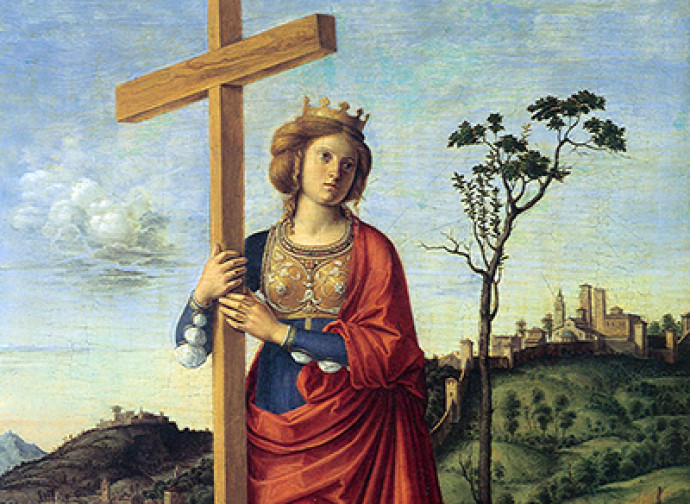Saint Helena
She was the mother of the emperor Constantine and the woman rich in faith who found the True Cross

Saint Helena (c. 249-329), famous for being the mother of the emperor Constantine and the woman rich in faith who found the True Cross, had humble origins. According to the account of St Ambrose (340-397), she was a good stabularia - an innkeeper who also had to look after the stables. It is believed that she was born in Bithynia, in ancient Drepanum, a city that her son later named Helenopolis in her honour. It was perhaps while travelling in those lands that a career soldier, Constantius Chlorus, fell in love with her and took her as his wife (or concubine); she gave birth to Constantine, their only son. The beginning of the Tetrarchy (293-305) upset Helena’s life, as she was subjected to humiliation. When Constantius Chlorus became Caesar of the Western Emperor Maximian, who gave him his stepdaughter Theodora as a wife, he decided to repudiate Helena, driving her away from home. At that time the young Constantine was sent to the court of Diocletian, Emperor of the East.
It is not known exactly how the future saint lived those years in hiding, but it is possible that she stayed close to her son, even though she did not live at court. In 306, when his father died, Constantine was proclaimed emperor of the West by the soldiers. Six years later, Constantine was victorious over Maxentius at the battle of Ponte Milvio (Milvian Bridge), preceded by the famous vision of the luminous cross and a prophetic inscription (In Hoc signo vinces, in Latin translation). With the edict of Milan (313) Christianity obtained the definitive recognition of freedom of worship, after the long persecutory campaigns of the previous three centuries. It is difficult to establish whether it was the emperor who brought his mother closer to the Christian faith, as Eusebius of Caesarea wrote in his Life of Constantine (337), or vice versa, as Saint Ambrose later claimed. But it is certain that Helena was not deceived by the imperial luxuries and privileges, not even after her son gave her the title of Augusta and had coins minted with her image.
Instead, she showed great devotion and charity. She helped the poor with clothes and money donations, invited them to lunch and served them, and freed some prisoners from unjust oppression. She went to church in modest clothes, as a simple worshiper. In 326 a convoluted and still obscure family tragedy took place: the villain was Constantine, who ordered the murder of his firstborn son Crispus and then of his second wife Fausta. Towards that time, at the end of her earthly life, Helena undertook a penitential pilgrimage to the Holy Land, presumably also to implore the grace of the repentance of her son. The pilgrim empress worked (as Eusebius already reported) to have the basilica of the Nativity built in Bethlehem, near the grotto where Jesus was born, and that of the Ascension on the Mount of Olives.
While she was in the Holy Land she collaborated with Bishop Saint Macarius of Jerusalem. She had a pagan temple on Calvary destroyed. And after the excavations, which brought to light the Holy Sepulchre, she found the Cross on which Jesus had been crucified, together with the Titulus Crucis with its triple inscription in Latin, Hebrew and Greek (John 19, 19-22), the nails of the crucifixion, and the crosses of the two thieves. She then promoted the construction of the basilica of the Holy Sepulchre, composed of the churches of the Martyrion and the Anastasis (Resurrection). The relics of the True Cross were distributed in various places of Christianity, as attested around 348-350 by the Catecheses of St Cyril of Jerusalem (“all the Earth is full of the relics of the Cross of Christ”). The oldest evidence of how the True Cross was identified can be found in the writings of Socrates Scholasticus (c. 380-440), Sozomen (c. 400-450), and Theodore of Cyrus (c. 393-457), with very similar versions based on a consolidated tradition.
This is Theodoretus’ account: “When the empress saw the place where the Saviour had suffered, she immediately ordered that the idolatrous temple that had been erected there be destroyed, and that the very earth on which it stood be removed. When the tomb, which had been hidden for so long, was discovered, three crosses were seen beside the Lord's tomb. All thought certain that one of these crosses was that of Our Lord Jesus Christ, and that the other two were of the thieves who had been crucified with Him. Yet they were unable to determine which of the three had held the Body of the Lord, and which had received the flow of His precious Blood. But the wise and holy Macarius, governor of the city, resolved this question in the following way: he arranged for a lady of rank, who had long suffered from an illness, to be touched by each of the crosses, with a sincere prayer, and thus recognized the virtue that dwelt in that of the Lord. For the moment this Cross was brought to the lady's side, it cast out the terrible illness and healed her completely”.




